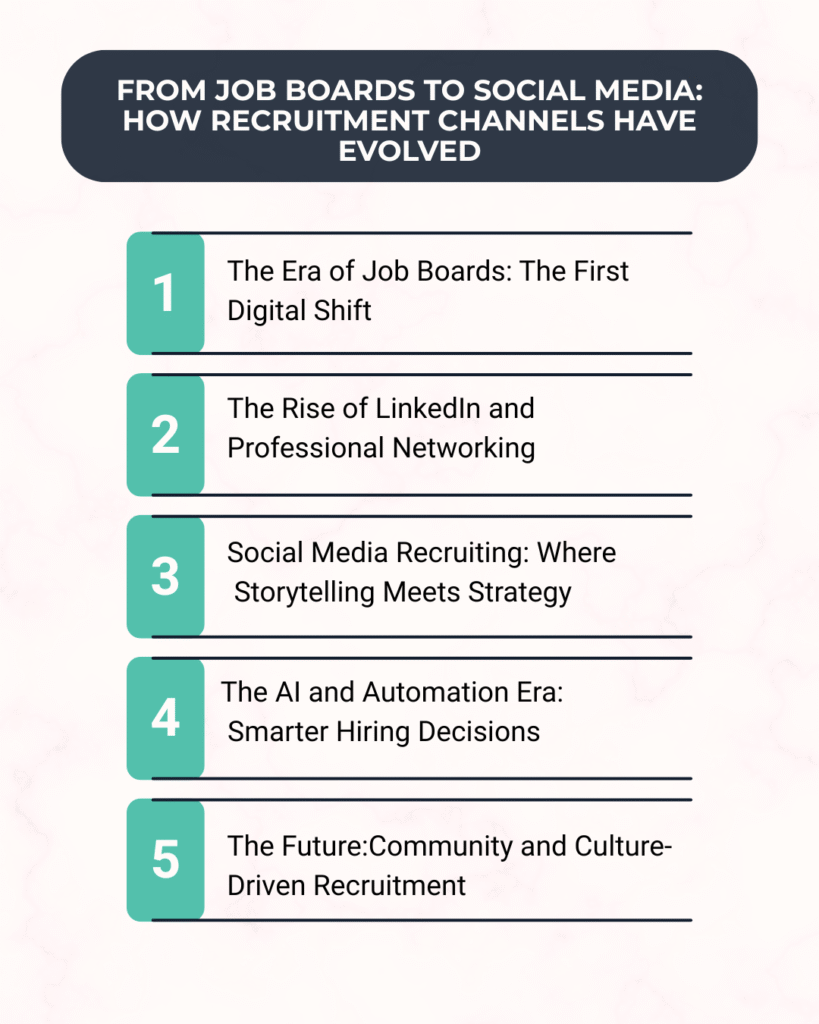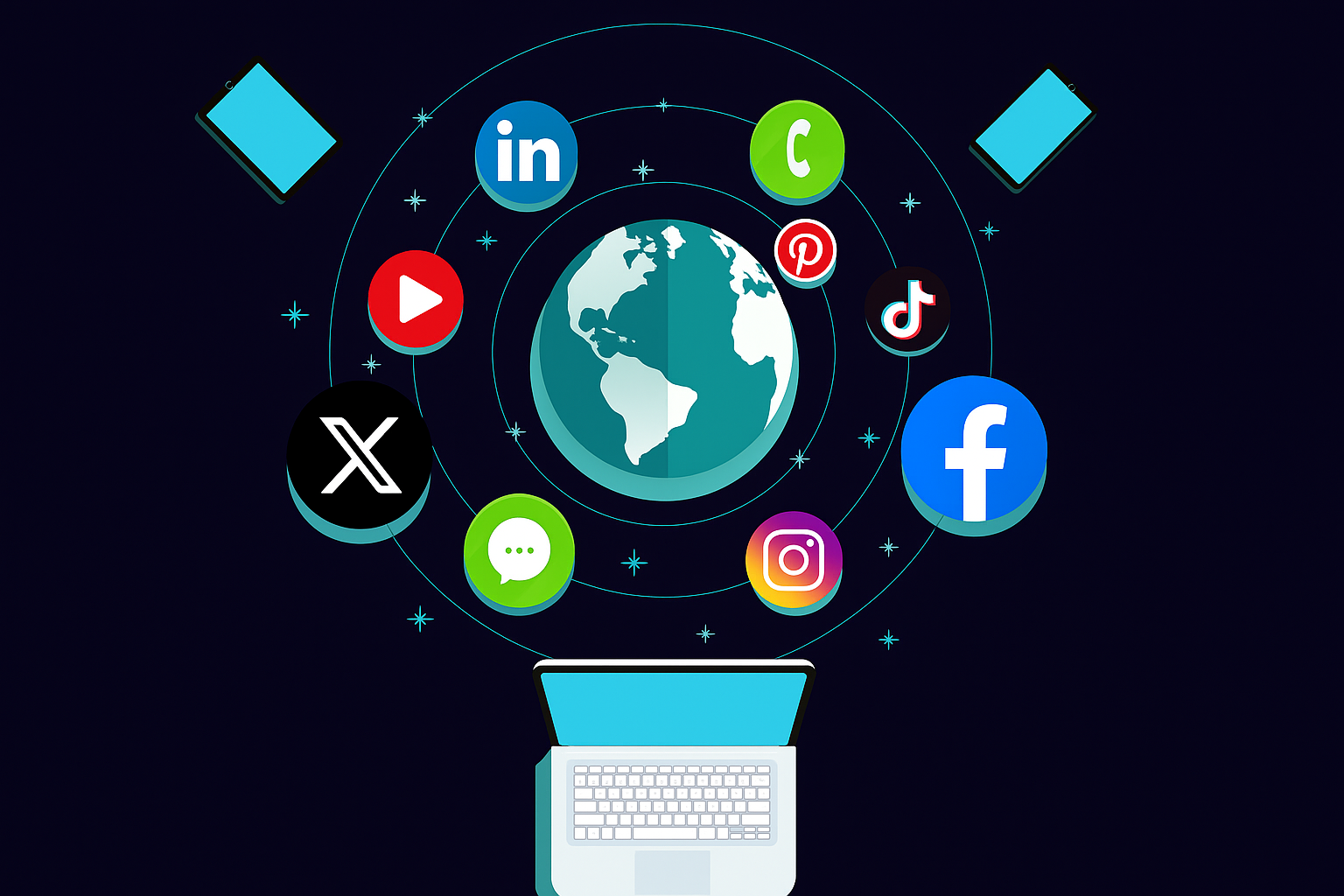The way we hire has changed more in the last 20 years than in the previous hundred. From paper resumes and newspaper ads to LinkedIn messages and TikTok recruiting videos, the recruitment landscape has undergone a complete digital transformation.
Today’s job market moves fast and so do the tools that connect employers with talent. The shift from traditional job boards to social media recruiting reflects not just a change in technology but also a change in how people think about work, culture, and opportunity.
You can also read: What is Influencer Marketing
In this blog, we’ll explore how recruitment channels have evolved over time, what’s driving these changes, and how companies can adapt to attract top talent in the modern digital age.

The Era of Job Boards
When online job boards like Monster, Indeed, and Glassdoor first appeared, they completely transformed hiring. Instead of posting jobs in newspapers or relying on walkins, employers could instantly reach thousands of candidates online.
For recruiters, it was efficient, scalable, and affordable. For job seekers, it meant endless access to opportunities with a single click.
However, the downside soon appeared too many applications and not enough quality. Recruiters started getting flooded with irrelevant resumes, making it difficult to identify the best talent.
Even today, job boards still play a role in high volume or entry level hiring, but they’ve become less effective for specialized or senior level positions where personalization and culture fit matter more.
The Rise of LinkedIn and Professional Networking
The launch of LinkedIn in 2003 marked a turning point in the recruitment world. It wasn’t just about posting jobs anymore it was about building relationships.
LinkedIn gave recruiters access to professional profiles, connections, and recommendations allowing them to find, assess, and approach candidates directly. It turned hiring into a proactive, data driven process rather than waiting for applicants to come to you.
For job seekers, LinkedIn became their personal brand hub a space to showcase experience, achievements, and values. Companies began using it for employer branding, sharing thought leadership, and connecting with talent on a deeper level.
But as the platform grew, so did competition. Today, standing out on LinkedIn requires creativity, authenticity, and meaningful engagement rather than just job postings.
Social Media Recruiting
Recruitment isn’t limited to LinkedIn anymore. Platforms like Instagram, Facebook, TikTok, and X (Twitter) have become powerful spaces for social media hiring and brand storytelling.
Companies now use short videos, reels, and posts to show what life inside their organization looks like giving candidates an authentic glimpse into the company culture.
For example:
- TikTok is used to showcase behind the scenes work culture and employee stories.
- Instagram highlights company events, achievements, and day in the life content.
- Facebook groups connect recruiters with niche talent pools.
This kind of storytelling humanizes brands. Instead of being faceless corporations, companies show real people, real stories, and real impact something modern candidates deeply value.
However, managing social media recruitment requires consistent engagement, creativity, and strategy. It’s not just about posting jobs; it’s about building a personality that attracts talent organically.
The AI and Automation Era
Artificial Intelligence (AI) is changing how companies find, screen, and hire candidates. Tools powered by AI can scan thousands of resumes in seconds, identify top matches, and even predict which candidates are most likely to succeed in a role.
AI driven recruitment tools like applicant tracking systems (ATS), chatbots, and predictive analytics make hiring faster and more data driven. Recruiters can now focus on human interaction while automation handles repetitive tasks like resume filtering and scheduling.
That said, the biggest challenge is keeping the human element alive. Over automation can make the process feel impersonal, and biased algorithms can unintentionally harm diversity efforts.
To make AI recruitment effective, HR teams need to combine technology with empathy using data to support decisions, not replace human judgment.
The Future: Community and Culture Driven Recruitment
The newest trend in recruitment isn’t about tools it’s about connection. Candidates today want more than a paycheck they want a sense of purpose, growth, and belonging.
That’s why leading companies are shifting toward community based recruitment building online spaces where professionals connect, learn, and engage before even applying for a job.
Whether through LinkedIn groups, Slack communities, or career newsletters, companies now focus on nurturing relationships long before they need to fill a position.
Employee advocacy also plays a huge role. When employees share authentic experiences on social media, they become powerful brand ambassadors who attract like minded talent.
This approach turns recruitment into a long term investment one that’s built on trust, transparency, and shared values.
How to Fix
While digital hiring tools are powerful, many organizations still face issues like low engagement, high turnover, or candidate ghosting. Here’s how to fix it:
- Balance Tech with Human Touch
Use automation to save time but don’t let it replace empathy. Personalized messages, thoughtful feedback, and human conversations still matter most. - Strengthen Employer Branding
Share real stories, team successes, and workplace values. Candidates are drawn to transparency and authenticity not generic marketing. - Go Omnichannel
Don’t depend on one platform. Combine job boards, referrals, social media, and in person events to reach a wider, more diverse audience. - Use Data Responsibly
Track recruitment metrics but ensure fairness and transparency. Avoid letting algorithms make final hiring decisions without human oversight. - Focus on Candidate Experience
From the first interaction to onboarding, make the process simple, respectful, and engaging. A positive experience builds long term brand loyalty.
Conclusion
The evolution from job boards to social media hiring shows how far recruitment has come from static job listings to dynamic, relationship driven experiences.
In 2025 and beyond, successful recruitment will depend on how well organizations blend technology with authenticity. AI will continue to enhance efficiency, but real human stories and connections will remain at the heart of great hiring.
Companies that embrace this balance using data smartly while showing genuine care for their people will not only attract top talent but also build stronger, happier, and more loyal teams.
FAQs
How has recruitment changed over the years?
Recruitment has evolved from newspaper ads and job boards to social media and AI driven platforms. It’s now more digital, strategic, and focused on candidate experience.
What is social media recruiting?
Social media recruiting uses platforms like LinkedIn, Instagram, and TikTok to attract, engage, and hire talent through storytelling and brand engagement.
How does AI improve recruitment?
AI automates resume screening, scheduling, and candidate analysis helping recruiters save time and focus on human interaction.
Why is employer branding important in hiring?
A strong employer brand helps attract top talent, build trust, and reduce turnover. It shows what makes your company a great place to work.
What is the future of recruitment?
The future is community based hiring where companies focus on relationships, culture, and long term engagement rather than one time job postings.

